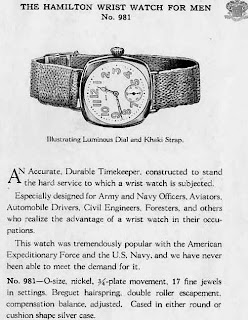Some debate exists about Hamilton’s first venture into the wristwatch business. According to the Catalogs, the Hamilton Wristwatch for Men first appeared in 1919. Enthusiasts have long held that the Company released their first wristwatch for men in that year. The catalog page below gives a different hint since it reads …this watch was tremendously popular with the American Expeditionary Force and the U.S. Navy, and we have never been able to meet demand for it…
Officially, when the United States went to war in 1917, the Army supposedly turned to Hamilton for timekeeping needs. The Corps of engineers purchased 1,000 Hamilton pocket watches for the supervision of railroad operations in France. That’s not exactly the kind of requisition that can establish a company as the standard bearer.
Hamilton 1917-23 Photos and Descriptions
The United States participated in World War I from April 6, 1917 until November 11, 1918, yet the movement in the 1919 release uses a one inch caliber 981 . Hamilton released that caliber in 1919 giving some credence to the generally accepted belief the Company entered the business then.
Hamilton introduced its first wristwatch in 1917. They designed it to appeal to men entering World War I. That watch contained the 1 inch (0-sized) 17-jewel 983 movement. They originally designed the 983 for women’s pendant watches and released it in 1908. Production ceased in 1918 and totalled 6900 units. The Company placed the movement into service for one year. They never advertised it in any catalog. Rough estimates say that Hamilton cased 1500 of these watches.
 Hamilton also produced a like number of 19 Jewel men’s watches between 1917 and 1918. The 985 movement also measured 1 inch (0-sized). Production for this movement totalled 5800 units between 1908 and 1918. Again, the designers produced this movement for women’s pendant watches. They never advertised this watch in any catalog either.
Hamilton also produced a like number of 19 Jewel men’s watches between 1917 and 1918. The 985 movement also measured 1 inch (0-sized). Production for this movement totalled 5800 units between 1908 and 1918. Again, the designers produced this movement for women’s pendant watches. They never advertised this watch in any catalog either.
Hamilton produced the 981 movement, advertised in the 1919 catalog, for four years. It appears the Company produced it exclusively for their Wristwatch for Men. Hamilton wrote that they could not keep up with demand. Maybe that is true. Their serial numbers indicate that they produced 2200 units between 1919 and 1922.
As my friends in the UK would say, “What a lot of touch.” If they could not keep up with demand, the demand was weak. Let’s face it Hamilton made railroad watches and a lot of them. In fact, Hamilton sold more railroad watches than anyone else.
We’ve all heard the saying that Hamilton’s management felt that wristwatches had no real place in a man’s world. Frankly, it had little to do with that. It was simply a matter of economics.
 |
| The “trench” watch from World War I |
You can get a real sense of Hamilton’s business model when you compare their men’s wristwatch to Elgin’s model 462 Cushion. The Elgin 462 was a seven jewel movement and contributed 9,000 units in 1919 to Elgin’s total watch business.
The 462 sold about six times the number of Hamilton’s Wristwatch for Men. Do the movement’s compare? No – not at all. Hamilton’s model 981 movement was a Rolls Royce. Elgin’s was the Morris Minor with leaky tires.
From a consumer’s point of view, you would have to say that they looked similar. Looks in Hamilton’s eyes were irrelevant. The folks in Lancaster considered quality everything. They believed that something made cheaply would have hurt their other sales. I believe they were accurate.
 |
| Elgin Cushion circa 1919 Model 462 |
Copyright 2006-2017 | All Rights Reserved
